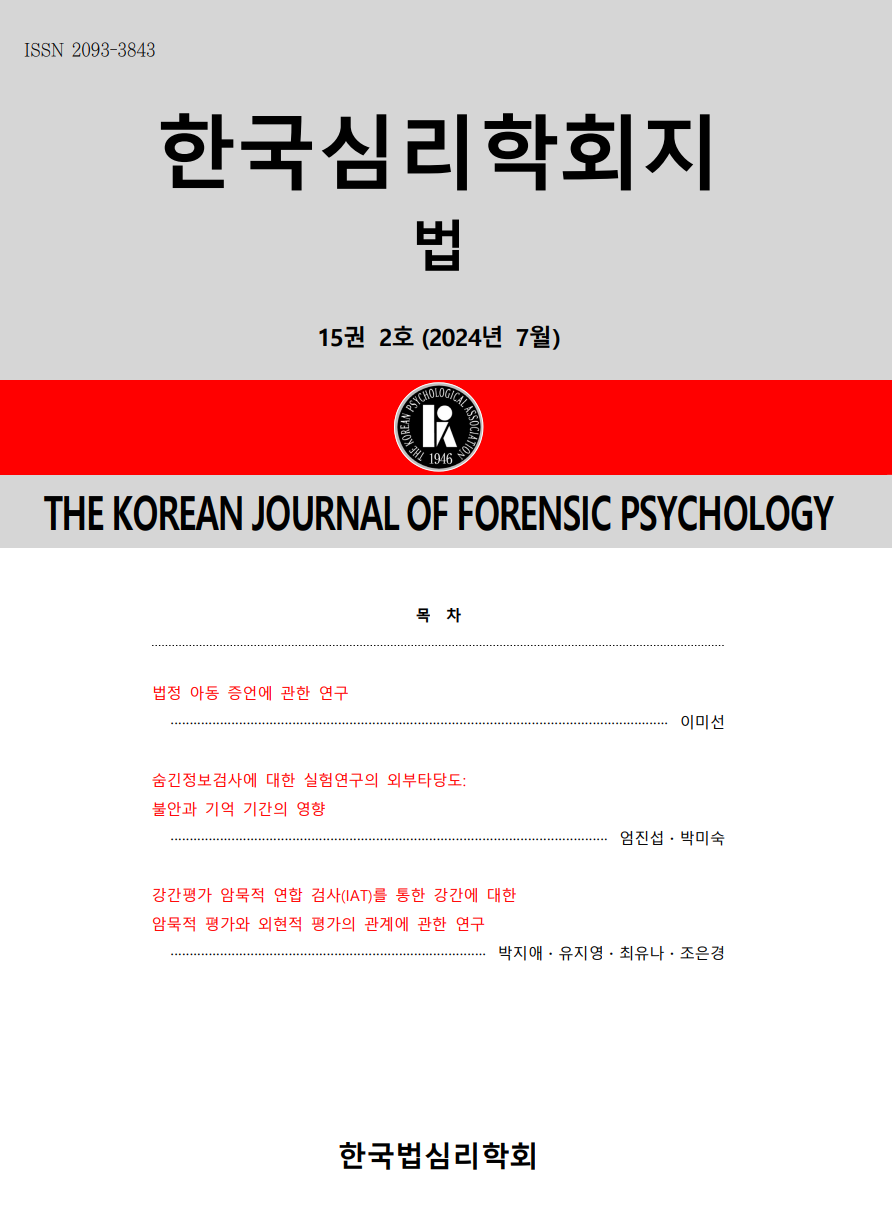open access
메뉴
open access
메뉴 ISSN : 2093-3843
ISSN : 2093-3843
In this study, 604 inmates in correctional facilities were classified into four types of crime in order to identify the characteristics of their crime patterns, and the character-assessment questionnaire (PAI-PS) they conducted was analyzed through ANOVA One-Way Analysis and Cluster Analysis to examine their psychological and emotional characteristics. Significant differences were found between the types of crime in the SOM, SOM-H, MAN, MAN-A, BOR, BOR-S, ANT, ANT-A, and ALC scales on clinical scales, and AGG and AGG-A on treatment and interpersonal scales. AGG-P, NON, and DOM scales showed differences between crime types. The results of a cluster analysis to find out how inmates are distinguished according to scores on the PAI-PS scale and the sub-scale showed that Cluster 1 was divided into ‘Sentence and Accident Instability Group’, Cluster 2 was ‘Dpression and Stress-Host Group’ and Cluster 3 was ‘Groups that do not complain of psychological and emotional problems’. This study is meaningful in that it provides information for individual understanding of water types in calibration facilities by identifying PAI-PS profile characteristics according to crime types and analyzing clusters according to scores of PAI-PS scales and sub-scale, which could provide basic data for each type of treatment program suitable for each type of water type in the calibration system.
강은영 (2008). 살인범죄의 실태와 유형별 특성. 형사정책연구원 연구총서, 1-2, 545.
고제원 (2013). PAI프로파일 상에 나타난 소년범죄자의 특성. 한국법학회, 50, 329-349.
김영환, 김지혜, 오상우, 임영란, 홍상황 (2001). PAI 표준화 연구: 신뢰도와 타당도. 한국심리학회지: 임상, 20(2), 311-329.
민정희, 강혜자 (2009). 교도소 수형자의 심리적 요인과 시설 내 적응태도. 교정연구, 45, 253-277.
박은영, 홍상황, 이전아, 김영환 (2001). 물질남용집단의 PAI프로파일 유형과 물질사용척도의 진단기능. 한국심리학회지: 임상, 20 (4), 711-730.
박은영, 홍상황, 정상문, 김영환 (2002). 수형자의 PAI 프로파일과 범법행위 예언지표. 한국심리학회지: 임상, 21(4), 941-954.
법무부 (2018). 2018 교정본부 통계자료. 법무부.
서진환, 이수정 (2000). 교정기관 재소자들의 정신건강문제. 한국사회복지학, 43, 131- 158.
심영희, 윤성근, 임희철, 김치곤 (1990). 재소자의 생활실태 및 의식에 관한 연구. 한국형사정책연구원, 17-353.
이동훈, 양모현, 권은비, 오대연 (2019). 범죄유형 및 수감기간에 따른 남성 출소자의 MMPI-2 반응 특성 비교. 한국재활심리학회, 26(2), 19-35.
이수정, 서진환, 이윤호 (2000). MMPI 점수로 본 교도소 수형자들의 정신건강 문제 실태 연구. 한국심리학회지: 일반, 19, 43- 62.
이수정 (2002). 재소자의 분류를 위한 심리평가의 효용성. 소년보호, 16(1), 한국소년정책학회, 215-251.
이수정 (2015). 최신범죄심리학(3판). 정신장애 범죄자를 위한 긍정심리기반 프로그램 개발과 효과. 서울: 학지사.
이수정, 박은영, 권해수, 김영환, 김지혜, 박중규, 조은경, 오상우, 이은호, 황순택, 홍상황. (2019 출판예정). 교정용 성격평가질문지(PAI-PS) 전문가용 실시요강. 서울: 학지사.
윤옥경 (2011). 교도소 수형자의 규율위반 행동에 대한 분석: 피해 경험과 절차적 공정성의 효과를 중심으로. 형사정책연구, 22(3), 391-424.
정유희, 안창일 (2004). 성별, 재범여부, 범죄유형에 따른 수형자의 NEO-PI-R 반응. 한국심리학회지: 임상, 23(3), 725-740.
정지숙, 조성희, 최지명 (2009). 정신감정이 의뢰된 성범죄자들의 MMPI-2 하위 유형에 따른 심리적 특성, 한국심리학회지: 임상, 28(4), 1049-1068.
홍정윤, 홍상황, 이수정 (2019). PAI 내현화 및 외현화 2요인 모형 검증 연구: 성인 교도소 수형자들을 대상으로. 한국심리학회지: 법, 10(1), 29-45.
Andrews, D., & Bonta, J. (2003). The psychology of crimi-nal conduct (3rd ed.). Cincinnati, OH: Anderson.
Ashford, J. B., Sales, B. D., & Reid, W. H. (Eds.). (2001). Treating adult and juvenile offenders with special needs. Washington, DC: American Psychological Association.
Clear, Todd R., & Cole Geroge. (2000). FAmerican, Correction, Belmont, CA: Wadsworth Publishing Company.
Deggenbacher, J. L., Oetting, E. R & DiGiuseppe, R. A. (2002). Principle of emprically supported interven-tions applied to anger management. The Counselling Psychologist, 30, 262-280.
Dolan, M, & Fullam, R. (2005). Factors influencing treatment entry in sex offenders against children. Medecine, Science, and the Law, 45, 303-310.
Edens, J. F., Hart, S. D., Johnson, D. W., Johnson, J. K., & Olver, M. E. (2000). Use of the personalirt Assessment Inventory to assess psychopathy in offender populations. Psychological Assessment, 12, 132-139.
Edens, J. F., Ruiz, M. A. (2005). PAI Interpretive Report for Correctional Settings. Psychological Assessment Resources.
Groom, B. (1999). Handing the triple whammy: Serious mental illness, substance abuse and criminal behavior. Corrections Today, 61, p.114-119.
Hare, R. D. (1991). The Hare Psycopathy Check-list Revised. Toronto: Multi-Health systems.
Hollin, C. R. (2004). the essential Handbook of Offender Assesment and Threatmen. John Wiley & Sons Ltd.
Lester, D. (1995). Serial Killer: The Insatiable Passion. Philadephia: The Charles Press, Publishers.
Litwack, T. R., & Schlesinger, L.B. (1987). Assessing and predicting Violence: Re-search, Law, and Applications. in Weiner, I. B & Hess, A. K. (eds). Handbook of Forensic Psychology. NY: John Wiley & Sons.
Link, B., & steuve, A. “Evidence Bearing on Mental Illness as a Possible Cause of Violent Behavior.” Epidemiology Reviews. 17. p172~ 181.
Morey, L. C. (1995). The personality and crime: Where do we stand. Psychology 2, Crime & Law, 2(3), p.141-152.
Meloy J. R., & Gacono, C. (1995). Assessing the psychopathic personality. In J. Butcher(Ed.), Clinical personality Assessment. New York: Oxford.
Rogers, R, Ustad, K. L & Salekin, R. T. “Convergent validity of the Personality Assesment Inventory: A study of emergency referrals in a correctionalsetting.” Assessment, 5, p.3-12, 1998.
Resnick, R. (1997). Malingered psycosis. In R. Rogers (ES.), Clinical assesment of malingering and deception. (2nd ed., p.47-67), New York: Guilford.
Rogers, R. (1997). Clinical assessment of malingering and depression (2nd ed.). New York: Guilford press.
Rubin, D, B., & Stocking, M. (1976). Criminality in XYY and XXY Men. Science, 193, p547
Simons, Cassandra L. (2001). “Antisocial Personality Disorder in Serial Killers: The Thrill of the kill”, The Justice Professional, 14(4), 345-356.
White, L. J. (1996). Review or the Personality Assesment Inventory(PAI): A new psychological test for clinical and forensic assesment. Australian Psychologist, 31, 38-39.